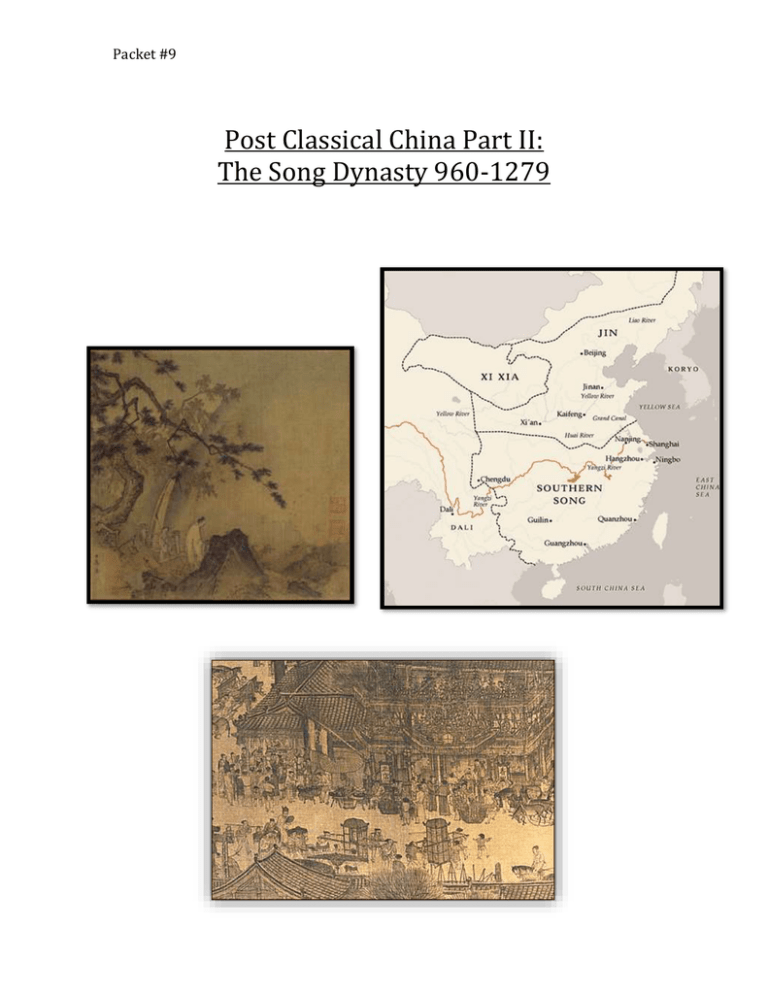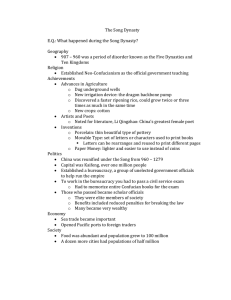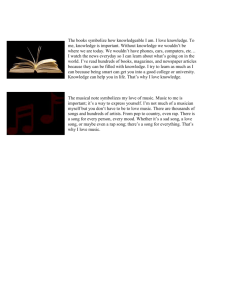Packet 9 - Pascack Valley Regional School District
advertisement

Packet #9 Post Classical China Part II: The Song Dynasty 960-1279 Packet #9 In this packet you will learn about… o China’s Song Dynasty o Source: http://afe.easia.columbia.edu/song/index.html Political: The Song never matched its predecessor in political or military strength. Song rulers strongly promoted the interests of the Confucian scholar-gentry, who touted themselves as the key bulwark against the revival of warlordism. Official’s salaries were increased, and many perks—including additional servants and payments of luxury goods such as silk and wine—made government posts more lucrative. The civil service exams were fully routinized They were given every three years at three levels: district, provincial, and imperial. The ascendancy of the scholar-gentry class over its aristocratic and Buddhist rivals was fully secured in the Song era. o The emphasis on civil administration and the scholar-gentry and the growing disdain among the Song elite for the military took its toll. Funds needed to upgrade weapons or repair fortifications often were diverted to the scholarly pursuits and entertainments of the gentry. o At the court and among the ruling classes, painting and poetry were cultivated, while the horseback riding and hunting went out of fashion. Economic REVOLUTION! Key points: Population boom, Urbanization, Paper Money, Commodities: Between 750 and 1100, China’s population doubled, money supply grew tenfold, paper money came into use, and trade and industry grew rapidly. There was no single cause of this great transformation. Advances in technology helped, especially in agricultural technology, and each advance helped foster others. Population Growth: By 1100, the population reached 100 million. China was certainly the largest country in the world at the time. Its population probably already exceeded that of all of Europe, as it has in more recent centuries. Urbanization: The quickening of the economy in Song times fueled the growth of cities. Dozens of cities had 50,000 or more residents, and quite a few had more than 100,000. The Song’s largest cities were its capitals — first Kaifeng in the North, then Hangzhou in the South. Both capitals are thought to have had Packet #9 about a million residents. (The population of London at the time was around 15,000). Cities had lively streets with markets Poverty was more of a problem in crowded cities than in the countryside. The Song government not only distributed alms, but operated public clinics, old age homes, and paupers’ graveyards. Commercialization: Farmers in Song China did not aim at self-sufficiency. They had found that producing for the market made possible a better life. Farmers sold their surpluses in nearby markets and bought charcoal, tea, oil, and wine. Some of the products on sale in the city depicted in the scroll would have come from nearby farms, but others came from far away. In many places, farmers specialized in commercial crops, such as sugar, oranges, cotton, silk, and tea. Growth of the Merchant Class: Merchants in the cities became progressively more specialized and organized. They set up partnerships and joint stock companies, with a separation between owners (shareholders) and managers. In large cities merchants were organized into guilds according to the type of product they sold. Guilds arranged sales from wholesalers to shop owners and periodically set prices. When the government wanted to requisition supplies or assess taxes, it dealt with the guild heads. The Grand Canal linked the North to the Yangzi River region. Marco Polo: Was astounded at the boat traffic on the Yangzi River. He claimed to have seen no fewer than 15,000 vessels at one city on the river, and said other towns had even more. o Marco Polo (1254-1324), is probably the most famous Westerner traveled on the Silk Road. Traveled 5,000 miles. Documented East Asia. Paper Money: The Song Dynasty used paper money. o As trade increased, demand for money grew enormously, so the government minted more and more coins. By 1085 the output of coins had increased tenfold since Tang times to more than 6 billion coins a year. o The use of paper currency was initiated by merchants. To avoid having to carry thousands of strings of coins long distances, merchants in late Tang times (c. 900 CE) started trading receipts from deposit shops where they had left money or goods. The early Song authorities awarded a small set of shops a monopoly on the issuing of these certificates of deposit, and in the 1120s the government took over the system, producing the world’s first government-issued paper money. Iron and Steel Packet #9 o During Song times, heavy industry — especially the iron industry — grew astoundingly. Iron production reached around 125,000 tons per year in 1078 CE, a sixfold increase over the output in 800 CE. Textiles and Silk: o The common people mostly wore clothes made of plant fibers such as hemp and ramie, and, at the end of the period, cotton — but the most highly prized fabric at home and abroad was silk. o The feeding of silkworms (which devoured vast quantities of mulberry leaves), the cleaning of their trays, the unraveling of the cocoons, the reeling and spinning of the silk filaments — all this was women’s work, as was the weaving of plain cloth on simple home looms. o Professional weavers, mostly men working in government or private workshops, operated complex looms to weave the fancy damasks, brocades, and gauzes favored by the elite. (Silk weavers pictured) Ceramics: o In English, “china” has become synonymous with dinnerware. Already in Song times China was a ceramics-exporting country. o Song kilns produced many kinds of cups, bowls, and plates, as well as boxes, ink slabs, and pillows (headrests). Techniques of decoration ranged from painting and carving to stamping and molding. Some kilns could produce as many as 20,000 objects a day for sale at home and abroad. Shards of Song porcelain have been found all over Asia Interaction with the Environment: RICE CULTIVATION During Song times, new developments in rice cultivation — especially the introduction of new strains of rice from what is now Central Vietnam, along with improved methods of water control and irrigation — spectacularly increased rice yields. Rice was used primarily as food, but was also used to brew the wine consumed in homes and taverns. Because the variety of rice was relatively more drought-resistant, it could be grown in places where older varieties had failed, especially on higher land and on terraces that climb hilly slopes, and it ripened even faster than the other early-ripening varieties already grown in China. Packet #9 Technology Shipbuilding: The Song Chinese were world leaders in shipbuilding. Watertight bulkheads improved buoyancy and protected cargo. Stern-mounted or stern-post rudders (see right) improved steering. Sounding lines were used to determine depth. Some ships were powered by both oars and sails and large enough to hold several hundred men. Also important to oceangoing travel was the perfection of the compass. Gunpowder: Song military engineers found gunpowder to be helpful in siege warfare, leading to the development of early types of rockets, cannons, bombs, and mines. Song efforts to continually improve their weapons were one reason they were able to hold off the Mongols for several decades. The Mongols would ultimately also adapt and overcome the Chinese. The Wujing zongyao (“Collection of the Most Important Military Techniques”), a military manual from 1044 CE, records the first true gunpowder formula and describes how to produce it on a large scale. Social: Continuing from the Tang Dynasty, the Song period saw the full flowering of one of the most distinctive features of Chinese civilization — the scholarofficial class certified through highly competitive civil service examinations. Most scholars came from the landholding class, but they acquired prestige from their learning and political clout by serving in office. In a society in which most people were illiterate, scholar-officials stood out by virtue of their reading and writing skills. Their Confucian education encouraged them to aspire for government service, but also to speak up when they thought others were pursuing the wrong course, making them courageous critics of power. In the Song, however, that the examination system came to be considered the normal ladder to success. To prepare for the examinations, men would memorize the Confucian classics in order to be able to recognize even the most obscure passages. As part of the exam they had to write poetry. Men often took the examinations several times, and were on average a little over 30 when they succeeded. The great majority of those who devoted years to preparing for the exams, however, never became officials. Packet #9 Art: In the Song period the engagement of the elite with the arts led to extraordinary achievement in calligraphy and painting, especially landscape painting (below) Neo Confucianism: Confucianism dominated intellectual life. The most prominent thinkers of the era, such as Zhu Xi (joo shee), stressed the importance of applying philosophical principles ot everyday life and action. o These Neo-Confucians, or revivers of ancient Confucian teachings believed that cultivating personal morality was the highest goal for humans. Virtue could be attained through knowledge gained by book learning and personal observation as well as through contact with men of wisdom and high morality. o The Neo-Confucian emphasis on tradition and hostility to foreign influences was one of a number of forces that eventually stifled innovation and critical thinking among the Chinese elite. There was a vigorous revival of Confucianism in the Song period. Confucian teachings were central to the civil service examination system, the identity of the scholar-official class, the family system, and political discourse. Confucius’s own teachings, recorded by his followers in the Analects, were still a central element, as were the texts that came to be called the Confucian classics, which included early poetry, historical records, moral and ritual injunctions, and a divination manual Issues stressed by Confucian teachers changed as Confucianism became closely associated with the state from about 100 BCE on, and as it had to face competition from Buddhism, from the second century CE onward (After collapse of the Han Dynasty). The revived Confucianism of the Song period (often called NeoConfucianism) emphasized self-cultivation as a path not only to selffulfillment but to the formation of a virtuous and harmonious society and state. Confucianism and the Family: o In Confucian teaching, the family is the most basic unit of society. Everyone should respect and obey his or her parents and put the interests of the family before personal interests. This attitude of “filial piety” extended also to ancestors. It was considered essential that Packet #9 everyone marry, so that family lines would continue and male heirs make offerings of food and drink to their deceased ancestors. Neo Confucianism and Male Dominance: o Highly pronounced during the Song Dynasty o Advocated confining women and emphasized the importance of virginity for young brides, fidelity of wives, and chastity for widows. Widows (like India) were not to remarry o Men were permitted to have premarital sex without scandal, take concubines, remarry. o Neo Confucians attacked the Buddhists for promoting career alternatives for women, like scholarship and monastic life. o They drafted last ha favored men in inheritance, divorce, and familial interaction. o Excluded women from education. o Greatest expression of male dominance was in foot-binding. Practice in Chinese society to mutilate women’s feet in order to make them smaller; produced pain and restricted women’s movement; made it easier to confine women to the home. Barbarian Threats o Even though China was the economic powerhouse of East Asia, with by far the largest population, it was not militarily dominant and had to adjust to a multi-state context. o In this period when the horse was a major weapon of war, the grasslands north of China offered greater military advantage than China’s industrial prowess. o During the Song period, three non-Chinese groups formed states that controlled the grasslands to the north of the Song, where the colder, drier climate favored animal husbandry over crop agriculture. Over the course of four centuries, these Inner Asian states gained more territory occupied primarily by Chinese. Packet #9 SOCIAL POLITICAL ECONOMIC ENVIRONMENTAL Vocabulary Song Dynasty Population boom Urbanization Paper Money Marco Polo Definition Packet #9 Compass Gunpowder Landscape Painting Neo Confucianism Foot Binding




